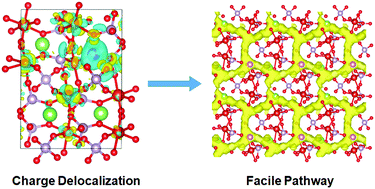当前位置:
X-MOL 学术
›
Energy Environ. Sci.
›
论文详情
Our official English website, www.x-mol.net, welcomes your
feedback! (Note: you will need to create a separate account there.)
A rechargeable aqueous Zn2+-battery with high power density and a long cycle-life†
Energy & Environmental Science ( IF 32.4 ) Pub Date : 2018-10-03 00:00:00 , DOI: 10.1039/c8ee01883a Fei Wang 1, 2, 3, 4, 5 , Enyuan Hu 4, 6, 7, 8 , Wei Sun 1, 2, 3, 4 , Tao Gao 1, 2, 3, 4 , Xiao Ji 1, 2, 3, 4 , Xiulin Fan 1, 2, 3, 4 , Fudong Han 1, 2, 3, 4 , Xiao-Qing Yang 4, 6, 7, 8 , Kang Xu 5, 9, 10, 11, 12 , Chunsheng Wang 1, 2, 3, 4
Energy & Environmental Science ( IF 32.4 ) Pub Date : 2018-10-03 00:00:00 , DOI: 10.1039/c8ee01883a Fei Wang 1, 2, 3, 4, 5 , Enyuan Hu 4, 6, 7, 8 , Wei Sun 1, 2, 3, 4 , Tao Gao 1, 2, 3, 4 , Xiao Ji 1, 2, 3, 4 , Xiulin Fan 1, 2, 3, 4 , Fudong Han 1, 2, 3, 4 , Xiao-Qing Yang 4, 6, 7, 8 , Kang Xu 5, 9, 10, 11, 12 , Chunsheng Wang 1, 2, 3, 4
Affiliation

|
Li-Ion batteries (LIBs) are approaching their energy limits imposed by their intercalation chemistry nature. As alternatives, multivalent (MV) chemistries bring both promises and challenges, with the main obstacle being the sluggish diffusion of MV-cations due to their strong electrostatic interaction with host lattices. In this work, we demonstrated that polyanion based robust crystal architecture could enable ultrafast and reversible Zn2+-intercalation and de-intercalation at a high working voltage. The nominal bivalence of Zn2+ was successfully delocalized by multiple atoms through the p–d hybridization between the V-d and O-p orbitals; hence the inserted Zn2+ only bears an effective charge of 1.336, rendering its high mobility. The novel aqueous rechargeable 1.7 V Zn/LiV2(PO4)3 cell based on such a mechanism delivers a high power density (8000 W kg−1 at 60C) comparable to supercapacitors, and a high energy density (218 W h kg−1 at 1C) close to LIBs, with an extraordinarily long cycle life of 4000 cycles. All of these parameters far exceed those of Zn batteries reported so far. The cell-level volumetric and specific energy densities of the Zn/LiV2(PO4)3 cell are 320 W h L−1 and 150 W h kg−1, respectively, which are even better than those of first-generation LIBs. Combined with the intrinsic safety of its aqueous chemistry and its wide working temperature range, this cell makes a strong candidate for automotive applications.
中文翻译:

具有高功率密度和长循环寿命 的可再充电Zn 2+水性电池†
锂离子电池(LIB)接近其嵌入化学性质所施加的能量极限。作为替代方案,多价(MV)化学带来了希望和挑战,主要障碍是由于MV-阳离子与主体晶格的强烈静电相互作用,导致MV-阳离子的扩散缓慢。在这项工作中,我们证明了基于聚阴离子的稳健的晶体结构可以在高工作电压下实现超快和可逆的Zn 2+嵌入和脱嵌。通过Vd和Op轨道之间的p–d杂化,Zn 2+的标称价双价被多个原子成功地定域。因此插入的Zn 2+仅承担1.336的有效费用,使其具有较高的移动性。新颖的水二次1.7 V的Zn /的LiV 2(PO 4)3基于这样的机制细胞提供了一个高功率密度(8000千克w ^ -1在60℃)相媲美的超级电容器,以及高能量密度(218 W时公斤- 1C时为1),接近LIB,具有4000个循环的超长循环寿命。所有这些参数都远远超过迄今为止报道的锌电池的参数。Zn / LiV 2(PO 4)3电池的电池级体积和比能量密度为320 W h L -1和150 W h kg -1分别比第一代LIB更好。结合其水溶液化学的本质安全性和宽广的工作温度范围,该电池成为汽车应用的强力候选者。
更新日期:2018-10-03
中文翻译:

具有高功率密度和长循环寿命 的可再充电Zn 2+水性电池†
锂离子电池(LIB)接近其嵌入化学性质所施加的能量极限。作为替代方案,多价(MV)化学带来了希望和挑战,主要障碍是由于MV-阳离子与主体晶格的强烈静电相互作用,导致MV-阳离子的扩散缓慢。在这项工作中,我们证明了基于聚阴离子的稳健的晶体结构可以在高工作电压下实现超快和可逆的Zn 2+嵌入和脱嵌。通过Vd和Op轨道之间的p–d杂化,Zn 2+的标称价双价被多个原子成功地定域。因此插入的Zn 2+仅承担1.336的有效费用,使其具有较高的移动性。新颖的水二次1.7 V的Zn /的LiV 2(PO 4)3基于这样的机制细胞提供了一个高功率密度(8000千克w ^ -1在60℃)相媲美的超级电容器,以及高能量密度(218 W时公斤- 1C时为1),接近LIB,具有4000个循环的超长循环寿命。所有这些参数都远远超过迄今为止报道的锌电池的参数。Zn / LiV 2(PO 4)3电池的电池级体积和比能量密度为320 W h L -1和150 W h kg -1分别比第一代LIB更好。结合其水溶液化学的本质安全性和宽广的工作温度范围,该电池成为汽车应用的强力候选者。









































 京公网安备 11010802027423号
京公网安备 11010802027423号